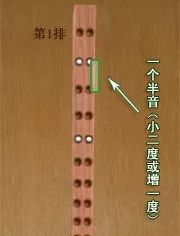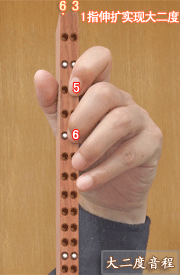Detailed graphic teaching of the fingering of the major and minor second intervals of the erhu
The interval is used to intuitively express the pitch relationship between musical tones. The unit of interval is "degree".
The degree of the interval expresses a relative pitch relationship between the two tones on the interval. This relationship not only has the difference in pitch between the two tones, but also expresses the degree of harmony between the two tones and their harmony. color.
The fingers are not only required to be arranged in the order of the fingers (finger order), but also have different requirements for the distance between the intervals during the action. The correct control of the finger pitch changes directly affects the accuracy of the intonation. Such as the clear difference between the major and minor second, the difference between the perfect fourth and the augmented fourth, and so on.
Pure degree is often used on two tones with different timbres (pure degree: 0 semitones, such as "2-2", "5-5"). The common ones are the "5" note of the inner string in the first position of D and the "5 note" of the outer string, which have the same pitch but different timbres. In the 4th, 8th, and 9th bars of "Good Night", the "55" sound is used in many places to set off the festive atmosphere. The increment is 1 semitone, such as "1-#1", "5-#5", as shown below

Pay attention to the difference between the minor second and the major second. In the music, the two semitones "3-4" and "7-`1" must be fingered with a minor second, not a major second. In music theory, the tendency of the leading tone to the main tone is often mentioned, so for the semitone "7-`1", the fingers should be brought closer together.
After understanding the basic meaning of the above-mentioned intervals, it is necessary to focus on the practice of intonation of each interval, such as the practice of scales and arpeggios of various keys. In the practice, the correct control of the specific finger spacing directly affects the accuracy of the pitch. In the alternate fingering, more attention should be paid to the strict finger spacing relationship, especially the rapid transition between each interval.
Now let's talk about how to practice the intervals of erhu big and small.
Erhu's minor second interval practice
"7->`1, 3->4" is a minor second. The former is a semitone between the leading and tonic. The number of notes in the minor second is 0.5, and the pitch between the two notes is a "semitone". The following are five fingerings to achieve the minor second interval (3-4) in actual performance. These five fingerings are very common in practical applications.
1. Practice the minor second interval of the same chord

The above picture takes G major (5.2 external strings in the first position) as an example, in which the two tones "3-4" are minor second intervals (semitone relationship), and the index and middle fingers are pressed together.
The minor second interval of the external strings of G major is in the low position. Because the finger spacing is relatively wide, the practice of this minor second interval is not too difficult. However, once the little finger and the middle finger are required to be pressed frequently in the music (such as "3464" pressing the finger quickly), the phenomenon that the middle finger is pressed to a higher pitch often occurs, such as pressing the "4" sound into the "#4" sound.
Commonly found on the first external strings are the 1-2 fingers of the C key (2 6) string, the "7 `1" of the 2-3 fingers of the D key (1 5) string, the A key (4 1) "3-4" of the 2-3 finger of the string, "7 `1" of the 3-4 finger of the key of E (b7. 4 string), etc.
2. Different strings minor second interval practice

The above picture shows the fingering of the minor second chord in the key of F "3-4".
On the real piano, "3" and "7" are in the same position (both use the little finger to press the finger), so when the little finger is pressed on the string, pulling the inner string is the "3" sound of the inner string; When the outer string is used, the sound is "7". If you first press the little finger (inner string) and then the index finger in the picture, the actual effect is to press the fingers of the two tones "3, 4" (minor second interval).
3. Using semitone shift

The picture above shows the "3-4" minor second semitone in the key of G. Since the index finger moves back and forth, the tiger's mouth also moves up and down, so this is a finger-pressing technique of half-tone change.
4. Use the index finger to extend the sound

The above picture shows the two tones of “7-`1” in the key of C. Generally, two methods of “moving finger” and “sliding finger” can be used to press the finger. The picture is a movement exercise of the index finger. This fingering does not move. Since the tiger's mouth does not move when the finger is pressed, the position of the handle has not changed, and it is still the second position, which is the difference from the picture above.
5. The little finger expands the finger and presses the sound

The above picture adopts the finger shape of the little finger amplifying. Similarly, two methods of "moving finger" and "sliding finger" can be used to press the finger. This fingering tiger's mouth did not move. Since the tiger's mouth does not move when the fingers are pressed, the position of the handle has not changed, and it is still the second position.

Erhu major second interval practice
"1->2" "2->3" "4->5" "5->6" "6->7" are common major second intervals. The number of tones in a major second is 1, and the interval between two tones is a "whole tone". The pitch between two tones is a "whole tone" (equivalent to the distance between two semitones). The following four examples are typical applications.
Fingering of the three tones of "456" in the key of G

This kind of finger pressing has already appeared in other columns. The key point of the practice here is to pay attention to the pressing finger of two major second degrees. These two major second degrees are: 2-3 interdigital and 3-4 interdigital.
Note: When pressing the fingers, also pay attention to the interval between the fingers 2-4 which is a major third, because the sum of two major second intervals is equal to a major third interval.
Fingering of the four tones of "4567" in the key of F

The above picture is the finger of the external string in the first position of F major. It also appeared in the "Frequency Practice" column. Here we focus on the finger of the external string augmented by the fourth. When pressing the fingers, all four fingers should be in a separated state, that is, the distance between each finger is a major second interval.
The "major second" fingering with the index finger extending upwards

In the second position of the external string in the key of F in the picture above, the index finger of the left hand extends upward to expand the sound, so as to realize the "5-4" major second finger.
Note: The three tones "5 6 7" in the picture are easy to pull in. The key is to press the finger of the outer string "4", which is to be pressed backward by the index finger (the index finger is extended up by a major second), rather than the method of changing the handle (except in special cases).
The "major second" fingering with downward extension of the little finger

The picture above shows the third position of the external string in the key of D. The little finger of the left hand extends downward to expand the sound, so as to realize the major second finger of "`4-`5".
Note: If the above picture is changed to G key, the same fingering method can achieve "`1-`2" major second fingering.
In addition to the most commonly used major second intervals above, in modern fingering, major second such as "7-#1", "b7-1" and so on are occasionally encountered.
 渝公网安备 50010702504639号
渝公网安备 50010702504639号